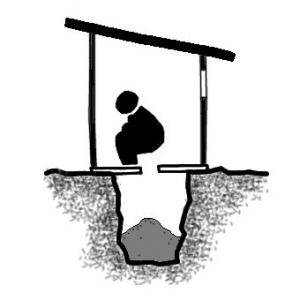Executive Summary
The single pit is one of the most widely used sanitation technologies. Excreta, along with anal cleansing materials (water or solids) are deposited into a pit. To avoid people falling into the pit, increase convenience and reduce odour, a slab with a hole is used to cover the pit. Lining the pit prevents it from collapsing and provides support to the superstructure , but the underground of the latrine should be water permeable . When the pit is filled up, it needs to be emptied or closed and relocated. By constructing twin pits (the double pit latrine), it should be possible to dig out a filled pit, after it has stood for a year, without any objectionable smell, whilst the other pit is in use. Consequently, the pits can be used more than once (no need to construct a new one every year) and there is less risk of ground water pollution in densely populated areas. However, the content of the pit still contains nutrients and maybe also some pathogens after one year and therefore needs to be reused or disposed appropriately (see also the chapter on recharge and reuse). Pit latrines are part of the improved sanitation options after the definition of UNICEF and WHO (2012). However, odour and fly nuisance are very common and due to soil infiltration there always remains the danger of groundwater contamination, especially in densely populated areas.
| In | Out |
|---|---|
Urine or Yellowwater, Faeces, Excreta, Dry Cleansing Materials, Anal Cleansing Water, Blackwater |
Faecal Sludge |
Introduction
The pit latrine (also called pit toilet) is one of the most widely used sanitation technologies. It is made out of a superstructure and a pit in which faeces, urine and anal cleansing material (water and/or solids) are disposed. Dry anal cleansing is advantageous to minimize water content and prevents fast fill up and groundwater pollution. To prevent people from falling into the pit and increase convenience and reduce odour, a slab with a hole should be used to cover the pit. A toilet seat can be installed over the hole. As the single pit fills, two processes limit the rate of accumulation: leaching and degradation. Urine and cleansing water trickle to the pit content (mixing up in a leachate) and percolate into the soil through the bottom of the pit and wall, while microbial action degrades part of the organic fraction. For that reason, underground of the latrine should be permeable. The pit latrine needs no water for its function which is an advantage in water scarce areas compared to flush toilets (see flush toilets, pour flush toilets or low-flush toilets). However, compared to other toilet systems such as UDDTS, composting toilet, twin-pits for pour flush, terra preta toilets, arborloo or fossa alterna, the treatment processes are limited (EAWAG/SANDEC 2008; TILLEY et al. 2008).
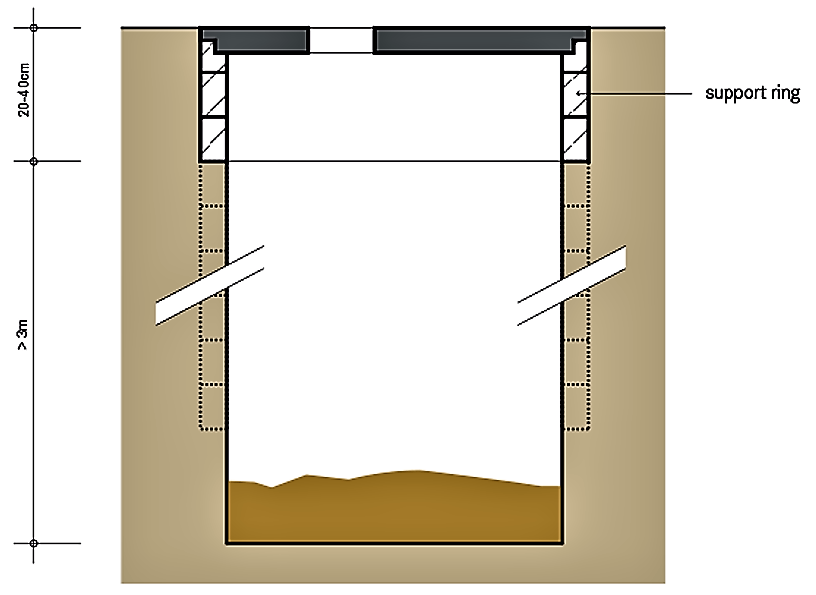
Design Considerations
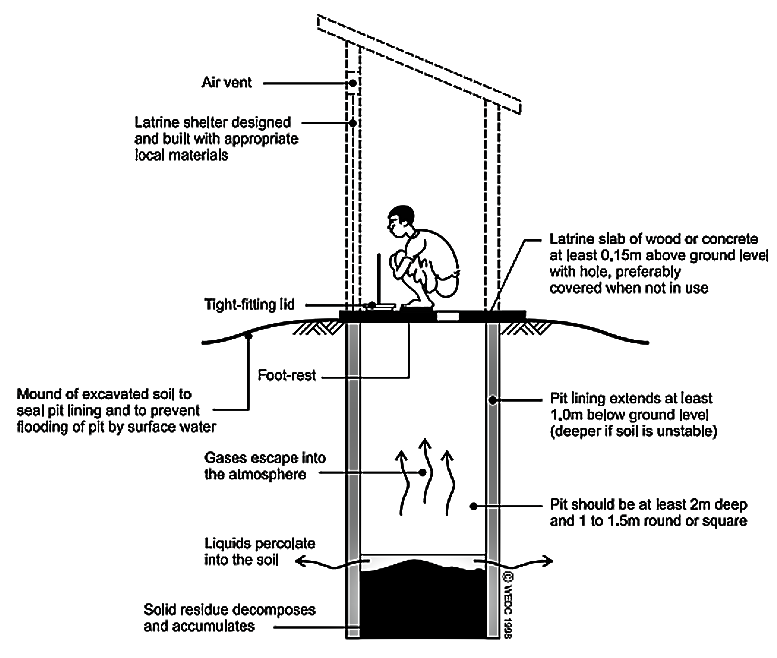
On average, solids accumulate at a rate of 40 to 60 L per person/year and up to 90 L per person/year if dry cleansing materials such as leaves or paper are used. The volume of the pit should be designed to contain at least 1,000 L. Typically, the pit is at least 3 m deep and 1 m in diameter. If the pit diameter exceeds 1.5 m, there is an increased risk of collapse. Depending on how deep they are dug, some pits may last 20 or more years without emptying. The longer a pit lasts, the lower will be the average annual economic cost and the greater the social benefits from the original input (WHO 1992). To prevent groundwater contamination, the bottom of the pit should be at least 2 m above groundwater level (rule of thumb). If the pit is to be reused, it should be lined. The lining also prevents the pit from collapsing and provides support to the superstructure. Pit lining materials can include brick, rot-resistant timber, concrete, stones, or mortar plastered onto the soil. If the soil is stable (i.e., no presence of sand or gravel deposits or loose organic materials), the whole pit need not be lined. The bottom of the pit should remain unlined to allow for the infiltration of liquids out of the pit.
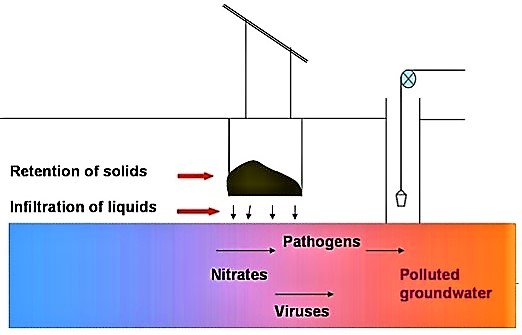
As liquid leaches from the pit and migrates through the unsaturated soil matrix, pathogenic germs are sorbed to the soil surface. In this way, pathogens can be removed prior to contact with groundwater. The degree of removal varies with soil type, distance travelled, moisture and other environmental factors and, thus, it is difficult to estimate the distance necessary between a pit and a water source. A minimum horizontal distance of 30 m is normally recommended to limit exposure to microbial contamination. In densely populated areas with many pit latrines it is often not possible to keep these distances between pollution sources and water abstraction points due to very limited space. In these areas, the risk of groundwater contamination and health risks associated with pit latrines is high and other sanitation options should be considered.
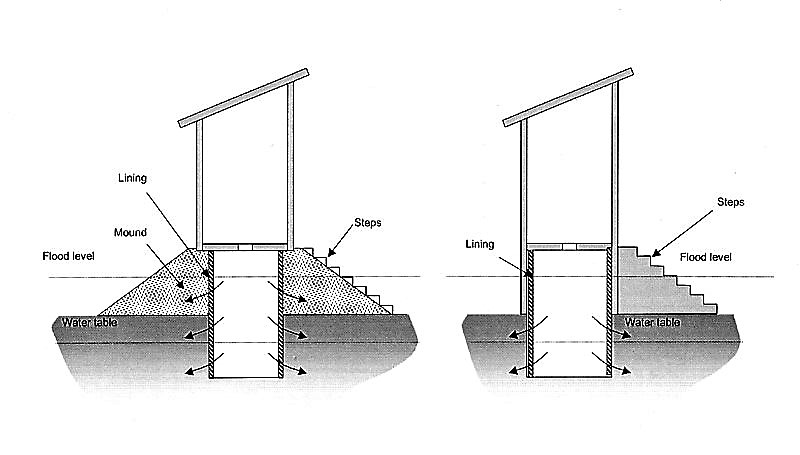
When it is not possible to dig a deep pit (e.g. in rocky soil) or the groundwater level is too high, a raised pit can be a viable alternative: the shallow pit can be extended by building the pit upwards with the use of concrete rings or blocks. A raised pit can also be constructed in an area where flooding is frequent in order to keep water from flowing into the pit during heavy rain. Another variation is the unlined shallow pit that may be appropriate for areas where digging is difficult. When the shallow pit is full, it can be covered with leaves and soil, and a small tree can be planted (see Arborloo). Urine diverting dry toilets could be a suitable option for regions with high groundwater table, as they are generally built above ground. In regions which tend to get flooded, “hanging UDDTs” are recommended.
Besides using twin-pits or double-pits, an upgrade of the pit latrine increases the value of the toilet, is economical and very easy to implement. A ventilated improved pit ( single VIP or double VIP ) is slightly more expensive than a single pit, but greatly reduces the nuisance of flies and odours, while increasing comfort.
If a urine-diverting user interface is used (see urine diversion toilet slab) , only faeces are collected in the pit and leaching can be minimized. The separately collected urine as well as the dehydrated faecal material in the pit can bereused as a nutrient rich fertiliser in agriculture (see also use of urine in agriculture at small and large scale, use of dehydrated faeces and compost in agriculture).
[no-ecompendium]Costs Considerations
Single pit latrines are very low costs, and are among the cheapest and easiest systems although almost no treatment is included. However, costs for relocation of emptying (see human powered and motorised) the pits need to be considered (WHO 1992).
Health Aspects/Acceptance
A single pit is an improvement to open defecation; however, it still poses health risks:
- Leachate can contaminate groundwater;
- Stagnant water in pits may promote insect breeding;
- Pits are susceptible to failure and/or overflowing during floods.
Single pits should be constructed at an appropriate distance from homes to minimize fly and odour nuisances and to ensure convenience and safety. The emptying (see human powered and motorised) of pit latrines containing fresh excreta presents problems because of the active pathogens in the sludge. Manual removal should therefore be avoided (WHO 1992).
Operation and Maintenance
There is no daily maintenance associated with a single pit apart from keeping the facility clean. However, when the pit is full it can be a) pumped out and reused (see also human powered and motorised emptying, use of compost in agriculture) - in order to minimize the health risk the pit can also be treated before reuse (see e.g. drying beds) - or b) the superstructure and squatting plate can be moved to a new pit and the previous pit covered and decommissioned, which is only advisable if plenty of land area is available.
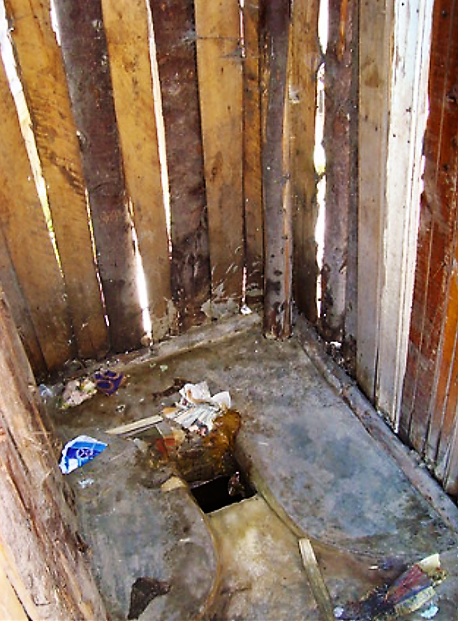
[no-ecompendium]At a Glance
| Working Principle | The pit latrine is one of the most widely used sanitation technologies. Excreta, along with anal cleansing materials (water or solids) are deposited into a pit. Lining the pit prevents it from collapsing and provides support to the superstructure. When the pit is full it can be pumped out or moved to a new location. |
| Capacity/Adequacy | The pit latrine is designed for rural and peri-urban areas. It is simple to build and can be constructed by the user itself with locally available material. |
| Performance | The treatment processes of the faecal material in the pit are limited and stagnant water may promote insect breeding. |
| Costs | Low-cost. |
| Self-help Compatibility | Can be built and repaired with locally available material. It must be maintained correctly and well-kept. |
| O&M | Apart from keeping it clean, there is no daily maintenance associated. |
| Reliability | If well maintained and constructed, the excreta is at least collected in the pit and risks of infections are lower. |
| Main strength | Low-cost; no water required; excreta is collected. |
| Main weakness | Odour and fly nuisance are very common and due to soil infiltration there is danger of groundwater contamination, especially in densely populated areas. |
Treatment processes in a single pit (aerobic, anaerobic, dehydration, composting or otherwise) are limited and, therefore, pathogen reduction and organic degradation is not significant compared to composting or dehydration toilets. Moreover, due to infiltration, the risk of groundwater contamination is high . However, since the excreta are contained, pathogen transmission to the user is limited.
Single pits are appropriate for rural and peri-urban areas; in densely populated areas they are often difficult to empty and/or have insufficient space for infiltration. Single pits are especially appropriate when water is scarce and where there is a low groundwater table. Depending on the pit depth, depth to the water table, number of users and soil conditions, some pits may last 20 or more years without emptying.
They are not suited for rocky or compacted soils (that are difficult to dig), or for areas that flood frequently. For areas where digging is difficult, the Arborloo could be a suitable option. As an alternative for regions with high groundwater table or frequent flooding, Urine diverting dry toilets could be considered .
Guidelines for Assessing the Risk to Groundwater from On-Site Sanitation
Many people in developing countries rely upon untreated groundwater supplies for their drinking water (e.g. from drilled boreholes, tube wells, dug wells or springs). The introduction of on-site sanitation systems might lead to groundwater contamination. The purpose of this manual is to provide guidance on how to assess and reduce the risk of contamination of groundwater supplies from on-site sanitation systems and is aimed at those responsible for planning low cost water supply and sanitation schemes.
ARGOSS (2001): Guidelines for Assessing the Risk to Groundwater from On-Site Sanitation. (= Commissioned Report , 142 ). Keyworth: British Geological Survey URL [Accessed: 11.05.2019]Latrine Building
Sanitation Systems and Technologies. Lecture Notes
Lecture notes on technical and non-technical aspects of sanitation systems in developing countries.
EAWAG/SANDEC (2008): Sanitation Systems and Technologies. Lecture Notes . (= Sandec Training Tool 1.0, Module 4 ). Duebendorf: Swiss Federal Institute of Aquatic Science (EAWAG), Department of Water and Sanitation in Developing Countries (SANDEC)Pit Latrines and Their Impacts on Groundwater Quality: a systematic Review
This study reviews empirical studies on the impact of pit latrines on groundwater quality and identifies knowledge gaps regarding the potential and consequences of groundwater contamination by latrines.
Graham, J. ; Polizotto, M.L. (2013): Pit Latrines and Their Impacts on Groundwater Quality: a systematic Review. Advance Publication. In: Environmental Health Perspectives: URL [Accessed: 09.04.2013]Emergency Sanitation: Assessment and Programme Design
This book has been written to help all those involved in planning and implementing emergency sanitation programmes. The main focus is a systematic and structured approach to assessment and programme design. There is a strong emphasis on socio-cultural issues and community participation throughout.Includes an extensive “guidelines” section with rapid assessment instructions and details on programme design, planning and implementation.
HARVEY, P. BAGHRI, S. REED, B. (2002): Emergency Sanitation: Assessment and Programme Design. Loughborough: Water, Engineering and Development Centre (WEDC) URL [Accessed: 31.05.2019]On-Site Sanitation in Areas with a High Groundwater Table
In areas that experience a seasonally high groundwater table or that are prone to flooding, constructing affordable on-site sanitation facilities can be very problematic. It is a challenge that affects many countries worldwide. This technical brief provides practical guidance on some sanitation options in such conditions.
PARRY-JONES, S. (1999): On-Site Sanitation in Areas with a High Groundwater Table. Leicestershire: , Engineering and Development Centre (WEDC) Loughborough University URL [Accessed: 31.05.2019]Low Cost Sanitation
Fact Sheets on Environmental Sanitation: Simple Pit Latrines
This factsheet contains practical information on the simple pit latrine.
ROBENS INSTITUTE (1996): Fact Sheets on Environmental Sanitation: Simple Pit Latrines. (= Fact Sheets on Environmental Sanitation ). Guildford / Geneva: University of Surrey, World Health Organization (WHO). Factsheet 3.4. URL [Accessed: 31.05.2019]Compendium of Sanitation Systems and Technologies. 2nd Revised Edition
This compendium gives a systematic overview on different sanitation systems and technologies and describes a wide range of available low-cost sanitation technologies.
TILLEY, E., ULRICH L., LÜTHI, C., REYMOND P. and ZURBRÜGG C. (2014): Compendium of Sanitation Systems and Technologies. 2nd Revised Edition. Duebendorf, Switzerland: Swiss Federal Institute of Aquatic Science and Technology (Eawag) URL [Accessed: 03.05.2023] PDFGuidelines for Assessing the Risk to Groundwater from On-Site Sanitation
Many people in developing countries rely upon untreated groundwater supplies for their drinking water (e.g. from drilled boreholes, tube wells, dug wells or springs). The introduction of on-site sanitation systems might lead to groundwater contamination. The purpose of this manual is to provide guidance on how to assess and reduce the risk of contamination of groundwater supplies from on-site sanitation systems and is aimed at those responsible for planning low cost water supply and sanitation schemes.
ARGOSS (2001): Guidelines for Assessing the Risk to Groundwater from On-Site Sanitation. (= Commissioned Report , 142 ). Keyworth: British Geological Survey URL [Accessed: 11.05.2019]Sanitation Systems and Technologies. Lecture Notes
Lecture notes on technical and non-technical aspects of sanitation systems in developing countries.
EAWAG/SANDEC (2008): Sanitation Systems and Technologies. Lecture Notes . (= Sandec Training Tool 1.0, Module 4 ). Duebendorf: Swiss Federal Institute of Aquatic Science (EAWAG), Department of Water and Sanitation in Developing Countries (SANDEC)Faecal Sludge Management.
This issue presents studies from different regions (Bangladesh, Cameroon, Burkina Faso) that mainly show the non-existence of faecal sludge management. Additionally, the last paper describes a new technological solution (LaDePa) for producing hygienically safe organic fertiliser from sludge from ventilated improved pit toilets (VIPs).
ECOSAN CLUB (2012): Faecal Sludge Management.. (= Sustainable Sanitation Practice , 13 ). Vienna: Ecosan Club URL [Accessed: 16.10.2012]Closing the loop – Ecological Sanitation for food security
This document was compiled during an international, interdisciplinary workshop in Mexico. This manuscript increases the understanding of how to develop more sustainable sanitation systems, particularly in urban/peri-urban contexts, while contributing to food production and improved nutrition.
ESREY, S.A. ANDERSSON, I. HILLERS, A. SAWYER, R. (2001): Closing the loop – Ecological Sanitation for food security. Stockholm: Swedish International Development Cooperation Agency URL [Accessed: 24.11.2010]Pit Latrines and Their Impacts on Groundwater Quality: a systematic Review
This study reviews empirical studies on the impact of pit latrines on groundwater quality and identifies knowledge gaps regarding the potential and consequences of groundwater contamination by latrines.
Graham, J. ; Polizotto, M.L. (2013): Pit Latrines and Their Impacts on Groundwater Quality: a systematic Review. Advance Publication. In: Environmental Health Perspectives: URL [Accessed: 09.04.2013]Emergency Sanitation: Assessment and Programme Design
This book has been written to help all those involved in planning and implementing emergency sanitation programmes. The main focus is a systematic and structured approach to assessment and programme design. There is a strong emphasis on socio-cultural issues and community participation throughout.Includes an extensive “guidelines” section with rapid assessment instructions and details on programme design, planning and implementation.
HARVEY, P. BAGHRI, S. REED, B. (2002): Emergency Sanitation: Assessment and Programme Design. Loughborough: Water, Engineering and Development Centre (WEDC) URL [Accessed: 31.05.2019]Applying the Life-Cycle Costs Approach to Sanitation
This briefing note presents an application of the life-cycle costs approach (LCCA) to sanitation in rural and peri-urban areas in four different countries— Andhra Pradesh (India), Burkina Faso, Ghana, and Mozambique. The document compares the differences between the financial costs of traditional and improved latrines, and the quality of service delivered to users.
IRC (2011): Applying the Life-Cycle Costs Approach to Sanitation. (= Briefing Note , 3 ). The Hague: International Water and Sanitation Center (IRC) URL [Accessed: 18.06.2019]How to Select Appropriate Technical Solutions for Sanitation
The purpose of this guide is to assist local contracting authorities and their partners in identifying those sanitation technologies best suited to the different contexts that exist within their town. The first part of the guide contains a planning process and a set of criteria to be completed; these assist you in characterizing each area of intervention so that you are then in a position to identify the most appropriate technical solutions. The second part of the guide consists of technical factsheets which give a practical overview of the technical and economic characteristics, the operating principle and the pros and cons of the 29 sanitation technology options most commonly used in sub-Saharan Africa.
MONVOIS, J. GABERT, J. FRENOUX, C. GUILLAUME, M. (2010): How to Select Appropriate Technical Solutions for Sanitation. (= Six Methodological Guides for a Water and Sanitation Services' Development Strategy , 4 ). Cotonou and Paris: Partenariat pour le Développement Municipal (PDM) and Programme Solidarité Eau (pS-Eau) URL [Accessed: 19.10.2011]Fact Sheets on Environmental Sanitation: Simple Pit Latrines
This factsheet contains practical information on the simple pit latrine.
ROBENS INSTITUTE (1996): Fact Sheets on Environmental Sanitation: Simple Pit Latrines. (= Fact Sheets on Environmental Sanitation ). Guildford / Geneva: University of Surrey, World Health Organization (WHO). Factsheet 3.4. URL [Accessed: 31.05.2019]How fast do pit toilets fill up? A scientific understanding of sludge build up and accumulation in pit latrines
A number of possibilities exist for using fecal sludge beneficially. Data provided by Water Services Authorities indicate that most pits are filling in five to nine years. This suggests that of the more than a million ventilated improved pit latrines that have been built in the past decade many will soon reach capacity. Studies of pit filling rates across a number of communities indicate that pits generally fill at a rate of 40 liters per capita annum, with 60 liters per capita annum providing a safe margin for planning pit design and emptying programs (Link-download is free but registration required).
STILL, D. FOXON, K. (2012): How fast do pit toilets fill up? A scientific understanding of sludge build up and accumulation in pit latrines. (= Tackling the Challenges of Full Pit Latrines , 2 ). Gezina, South Africa: Water Research Commission URL [Accessed: 15.01.2013]Adventures in search of the ideal portable pit-emptying machine
This article explores the ideal portable pit-emptying machine for South Africa owing to site access constraints. The Water Research Commission of South Africa funded experimental development of a number of technologies designed to fill the gap between large vacuum tankers and manual emptying. This paper describes these attempts.
STILL, D. O RIORDAN, M. MC BRIDE, A. LOUTON, B. (2013): Adventures in search of the ideal portable pit-emptying machine. Rugby: Practical Action Publishing URL [Accessed: 07.08.2013]How to Manage Public Toilets and Showers
The purpose of this decision-making aid is to provide practical advice and recommendations for managing toilet blocks situated in public places. It is primarily aimed at local decision-makers in developing countries and at their partners (project planners and managers).
TOUBKISS, J. (2010): How to Manage Public Toilets and Showers. (= Six Methodological Guides for a Water and Sanitation Services' Development Strategy , 5 ). Cotonou and Paris: Partenariat pour le Développement Municipal (PDM) and Programme Solidarité Eau (pS-Eau) URL [Accessed: 19.10.2011]Latrine and Sanitation Options Manual
This Manual aims to serve as a practical guide for the selection of sanitation technology options to satisfy local desires and meet national needs in Afghanistan. It is useful for the professionals and organisations working to address fecal contamination across Afghanistan.
USAID Afghanistan (2010): Latrine and Sanitation Options Manual. Sustainable Water Supply and Sanitation (SWSS) Project. Kabul: USAID Afghanistan URL [Accessed: 15.01.2013]Technology Notes
These technology notes have been prepared following many general enquiries for technical information having been received by WaterAid over the years. Their purpose is to give an outline of the technologies used by WaterAid on long-term development projects in Africa and Asia, and to show alternatives, which might be appropriate in different circumstances. It may be possible to determine from the notes the technology, which would be appropriate in a particular location.
WATERAID (2008): Technology Notes. London: WaterAid URL [Accessed: 04.01.2011] PDFA Guide to the Development of On-site Sanitation
The publication presents appropriate technologies for sanitation and highlights socio-economic aspects of planning and implementing. Emphasis is given to household-level sanitation improvements for urban areas, as well as rural areas and small communities. Background information on sanitation, in-depth technical information on the design, construction, operation and maintenance and project planning and development processes involved in projects and programmes complement the book.
WHO (1992): A Guide to the Development of On-site Sanitation. Geneva: World Health Organisation (WHO) URL [Accessed: 14.04.2010]Guidelines for the safe use of wastewater excreta and greywater. Volume IV. Excreta and Greywater Use in Agriculture
Volume IV of the Guidelines for the Safe Use of Wastewater, Excreta and Greywater recognizes the reuse potential of wastewater and excreta (including urine) in agriculture and describes the present state of knowledge as regards potential health risks associated with the reuse as well as measures to manage these health risks following a multi-barrier approach.
WHO (2006): Guidelines for the safe use of wastewater excreta and greywater. Volume IV. Excreta and Greywater Use in Agriculture. Geneva: World Health Organisation (WHO) URL [Accessed: 09.05.2019] PDFPit Latrines & their Impact on Groundwater in Small Towns in Uganda. A Case of Bugiri Town Council
This paper investigates the groundwater contamination due to poorly designed pit latrines and inadequate protected water sources.
KABONGO, I. KABISWA, C. (2008): Pit Latrines & their Impact on Groundwater in Small Towns in Uganda. A Case of Bugiri Town Council. Kampala: Ecological Christian Organisation URL [Accessed: 06.12.2010]From Pit Latrine to Ecological Toilet
This case study shows the problems of pit latrines in Garla Mare, Romania. After situation was analysed, several options were considered to improve the sanitation in the village.
SAMWEL, M. GABIZON, S. WOLTERS, A. WOLTERS, M. (2006): From Pit Latrine to Ecological Toilet. Utrecht/Munich: Women in Europe for a Common Future (WECF) URL [Accessed: 06.11.2010]Groundwater Contamination due to Pit Latrines Located in a Sandy Aquifer. A Case Study from Maputaland
This paper describes research of groundwater contamination due to pit latrines in the coastal plain of northern Kwa Zulu-Natal, South Africa.
STILL, D.A. NASH, S.R. (2002): Groundwater Contamination due to Pit Latrines Located in a Sandy Aquifer. A Case Study from Maputaland. Dorpspruit: Partners in Development URL [Accessed: 06.11.2010]A Directory of Environmentally Sound Technologies for the Integrated Management of Solid, Liquid and Hazardous Waste for Small Island Developing States (SIDS) in the Pacific Region
This directory is part of UNEP collaboration with SIDS on the implementation of the Waste Management chapter of the Barbados Programme of Action. It focuses primarily on proven sound environmental technologies for solid, liquid and hazardous waste management plus those currently successfully being used in SIDS within the Pacific Region.
UNEP (2002): A Directory of Environmentally Sound Technologies for the Integrated Management of Solid, Liquid and Hazardous Waste for Small Island Developing States (SIDS) in the Pacific Region. The Hague: United Nations Environment Programme (UNEP) URL [Accessed: 28.03.2012]The search for appropriate latrine solutions for flood-prone areas of Bangladesh
The appropriateness of latrine technology depends on groundwater table, geographical context and acceptance by the community. The current study discusses defferent technologies and solutions for excreta management in flood- and cyclone-prone areas of Bangladesh.
MORSCHED, G. ; SOBHAN, A. (2010): The search for appropriate latrine solutions for flood-prone areas of Bangladesh. In: Waterlines: Volume 29 URL [Accessed: 25.11.2015]A Practical Guide for Building a Simple Pit Latrine
This technical do-it-yourself guide provides step-by-step instruction on building simple pit latrines. It was designed for use at the individual household level to assist families in West Africa who have already decided to build their own latrines.The dialogue in the guide should be enacted by a facilitation team in the form of a skit followed by a debate. Each key step (placing the latrine, digging the pit, making the slab, building the superstructure) should be represented and followed by a discussion with the public, with responses and comments being provided for each step.
CAVANNA, S. DEBUS, J.-P. NIKIEMA, L.Z.P. (2011): A Practical Guide for Building a Simple Pit Latrine. West Africa Cluster: Global Water Initiative (GWI) URL [Accessed: 12.12.2011]Latrine Slabs
This poster is part of the series of Water, Sanitation and Hygiene posters designed by the Water, Engineering and Development Center of Loughborough University.
REED, B. SHAW, R. (2013): Latrine Slabs. (= WEDC Posters , 1 ). London: Water, Engineering and Development Center (WEDC) URL [Accessed: 07.08.2013]Simple Pit Latrines
This poster is part of the series of Water, Sanitation and Hygiene posters designed by the Water, Engineering and Development Center of Loughborough University.
REED, B. SHAW, R. (2013): Simple Pit Latrines. Poster. (= WEDC Posters , 10 ). London: Water, Engineering and Development Center (WEDC) URL [Accessed: 28.08.2013]Emptying Pit Latrines
This technical brief describes several possibilities of emptying pit latrines and helps to find the most suitable method.
PICKFORD, J. SHAW, R. (1997): Emptying Pit Latrines. (= Technical Briefs, No. 54 ). Loughborough: Water and Environmental health at London and Loughborough (WELL) URL [Accessed: 28.05.2019]Latrine Slabs and Seats
This technical brief describes pit latrines and possible slabs and seats to cover them.
WELL (n.y): Latrine Slabs and Seats. (= WELL Technical Briefs , 45 ). Loughborough: Water and Environmental health at London and Loughborough (WELL) URL [Accessed: 26.04.2010]Exercise. Pits for Latrines
How to construct good latrines in areas with flooding and high ground water: guide for experienced and new masons
A practical guide on construction latrines in flood areas, including schemes and FAQs.
EWB EWB (2015): How to construct good latrines in areas with flooding and high ground water: guide for experienced and new masons. EWB URL [Accessed: 25.11.2015]Information on improved latrine options
A practical guide on construction of different improved latrines, including resources and costs needed.
WSP-EAP WSP-EAP (2009): Information on improved latrine options. Jacarta : WB URL [Accessed: 25.11.2015]The Microbial Contamination of Water Supplies from Pit Latrines
This factsheet describes the microbiological contamination of water supplies. It gives an overview on pathogens and its characteristics as well as methods to reduce the risk of contamination.
WELL (2006): The Microbial Contamination of Water Supplies from Pit Latrines. (= WELL Fact-sheets ). Loughborough: Water and Environmental health at London and Loughborough (WELL) URL [Accessed: 07.12.2010]http://helid.digicollection.org/
This digital document contains all important information about pit latrines.
http://www.flickr.com/
This website contains pictures of different types of pit latrines.
WASHCost Mozambique: How much does it cost to build a traditional latrine?
This video by IRC’s WASHCost project examines the full costs of building traditional latrines in Mozambique. There, cost data for planning are collected by local authorities. They gather the information around households in the area. Households are visited and their sanitation situation is assessed. This gives a clear picture of what is actually achieved.

